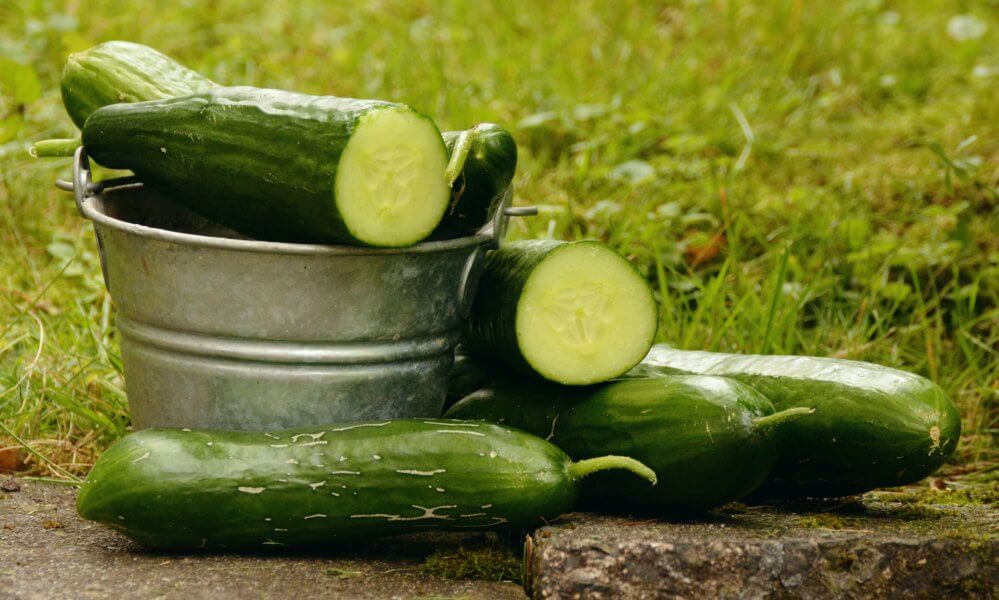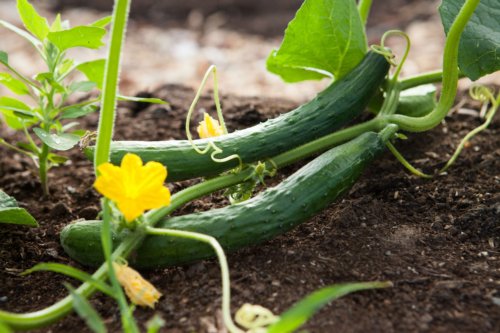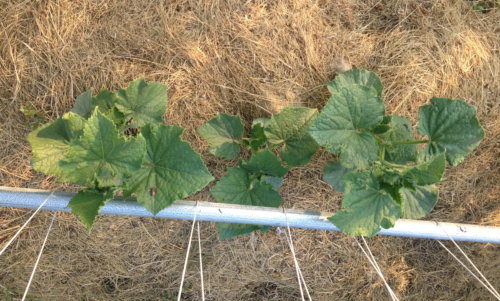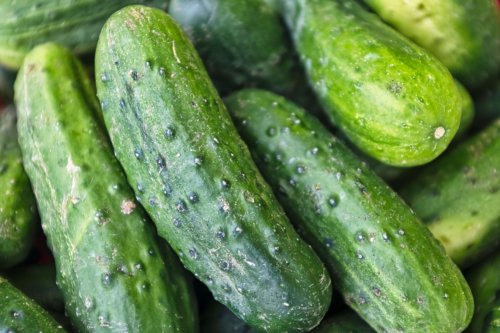7 Tips For Growing Cucumbers

Secrets To Growing Cucumbers
Today’s featured article are the 7 Tips For Growing Cucumbers – something everyone should know if they’re just starting out with a vegetable garden or are seasoned gardeners struggling with their cucumber crops. So here’s my story that had me looking for answers on why my cuc’s weren’t giving me good crops. Every year I’ve saved a spot in my garden for cucumbers because to me nothing beats the taste of picking one of these veggie’s fresh off the vine and adding them to my leafy dinner salad, or gathering up a few to make my mother-in-laws yummy cucumber salad. Ah yes, one of life’s simple pleasures (I am so easy to please).

And so every spring my routine is usually the same: the bed is prepared by removing all weeds (I pull them all by hand – never been one to just rototill them back in to the soil – see my WILL ROTOTILLING KILL WEEDS post ); the steed manure is added and mixed into the soil; seeds are plopped in and then within 4 weeks they are usually on their way up the trellis strings. But for some reason, this year they’ve been off to a slow start. Its been a good 7 weeks already and they are just now starting to make their way up the trellis. And with only a good month and half left of warm weather, I’ve got a hunch this years cucumber crop is going to be a big disappointment. So whats the dillio? What did I do differently this year?
After scouring around, I stumbled upon a great guide for growing cucumbers by Kris Wetherbee, at Organic Gardening. And according to Kris “If you follow these 7 tips … I promise that this year you’ll enjoy the coolest, tastiest cucumbers that no money can buy.” (these are her words not mine). Her 7 tips go like this – with full explanation below
- – plenty of water
- – mulch
- – afternoon shade if your temps are in the high 90’s
- – sunlight and good soil
- – fertilizer
- – no weeds
- – row covers or caps when seeds are just starting out
Yikes – I’ve never had to do this much work in the past.
 So lets go thru the checklist: My garden already gets plenty of water, and as you can see by the photo my plants are all mulched with a live cover of grass clippings, they get plenty of sunlight, the manure was added to enrich the soil with a fertilizer, and all the weeds are gone. The only other problem I can see is when the seeds were first planted. I’ve never used caps or covers in the past and have always had great success with my cuc’s. But I’m thinking because our weathers been so goofy this year, my stubby crop is probably due to the combination of no covers at planting, and the fluctuation of hot 90 degree temps during the day and the cool 50 degree temps at night. It could also be because of no afternoon shade. But these suckers are already in the ground and there’s no time to replant them or plant another taller crop around them. So sorry my cuc’s – I draw the line to holding an umbrella over your heads to keep the hot sun off ya’. Yeah – and that ain’t happenin’.
So lets go thru the checklist: My garden already gets plenty of water, and as you can see by the photo my plants are all mulched with a live cover of grass clippings, they get plenty of sunlight, the manure was added to enrich the soil with a fertilizer, and all the weeds are gone. The only other problem I can see is when the seeds were first planted. I’ve never used caps or covers in the past and have always had great success with my cuc’s. But I’m thinking because our weathers been so goofy this year, my stubby crop is probably due to the combination of no covers at planting, and the fluctuation of hot 90 degree temps during the day and the cool 50 degree temps at night. It could also be because of no afternoon shade. But these suckers are already in the ground and there’s no time to replant them or plant another taller crop around them. So sorry my cuc’s – I draw the line to holding an umbrella over your heads to keep the hot sun off ya’. Yeah – and that ain’t happenin’.

And so it goes, you live and learn something new every year when it comes to growing your own fruits and vegetables. So for future reference, now I know these tiny little seeds need some extra TLC at sowing time, and I also need to plant something tall around them to keep them cool during the scorching mid-afternoon sun. But until then, my fingers are crossed and a couple extra prayers will be said and maybe, just maybe, I will be lucky enough to be able to enjoy a couple of fresh, vine ripe cuc’s in my salad this fall. Until then … CIAO 🙂
GROWING CUCUMBERS – by Kris Wetherbee of Organic Gardening
Secrets of Growing Tasty Cuc’s
1. Keep them hydrated.
Provide plants with plenty of moisture, especially around the time the plant is flowering and fruiting. Any water stress during this period of rapid growth causes the levels of bitter-tasting compounds to rise. Cucumbers are vigorous growers and therefore need between 1 and 2 inches of water per week, depending on the weather and the characteristics of your soil. The key is to keep the soil slightly moist at all times. Water deeply about once or twice a week- more often if you’re gardening in sandy soil.2. Mulch.
You can further reduce water stress by mulching plants with an organic mulch. Mulch helps to conserve and moderate moisture levels while blocking out weeds. Plastic mulches can be applied at planting time, but wait until summer or after the soil has warmed to above 70 degrees before applying organic mulches, such as straw.3. Regulate the temperature.
Cucumbers like warm conditions, but growing cool and tasty cuc’s in the heat can sometimes be a challenge. In fact, high temperatures not only affect fruit quality; they can also affect fruit set by causing the plant to produce a higher ratio of male flowers. “Cucumbers are really sensitive to high heat,” says horticulturist Emily Gatch, greenhouse and pathology coordinator with New Mexico-based Seeds of Change. “It can be really hard on plants if temperatures are consistently in the mid-90s.” If you’re growing cucumbers in a hot climate, Gatch recommends providing plants with filtered afternoon shade to help cool things down, either by strategically planting taller crops at the southern end or by adding a shade cloth to block 40 to 50 percent of the sunlight.4. Give them sunlight and good soil.
For the best-tasting fruit and optimum yields, grow plants in a sunny spot and in warm, fertile, and well-drained soil rich in organic matter. Raised beds are ideal. Cucumbers require a soil pH between 6.0 and 7.0. Wait to sow seeds or set out transplants until after all danger of frost has passed and the soil has warmed to at least 60°F. An unexpected frost will kill plants, and the vines grow slowly and become stressed in cool conditions. You can start seeds indoors three to four weeks before your anticipated planting date outdoors. Be careful not to disturb roots when transplanting.5. Fertilize.
Cucumbers thrive in light, friable soil. Several inches of organic matter worked into the soil prior to planting helps achieve that goal. Plants are heavy feeders, so be sure to feed the soil with rich compost or aged manure. After the vines develop runners and the first flowers appear, follow up with a side dressing of compost, aged manure, or organic fertilizer. If the leaves are yellowish, the plants need more nitrogen. Make room. Giving plants the space they require is just one more ticket to a stress-free environment. Grow trellised plants 8 to 12 inches apart. Hills with one or two seedlings should be spaced about 3 feet apart, with rows 4 to 5 feet apart. Space bush varieties 3 feet apart in all directions.6. Banish weeds.
Keep your cucumber patch and the area around it free of weeds. Some types are hosts for bacterial wilt disease, which is spread by cucumber beetles. Intense feeding by these beetles can kill a plant, and they’re attracted to stressed plants- all the more reason to keep your plants healthy and happy.7. Cover up.
Row covers, hotcaps (or plastic milk cartons with the caps removed), and plastic tunnels are great for getting plants off to an early start. And row covers not only help plants grow faster and flower sooner, they also protect plants from pest insects. Just be sure to remove any covering once plants start to flower.